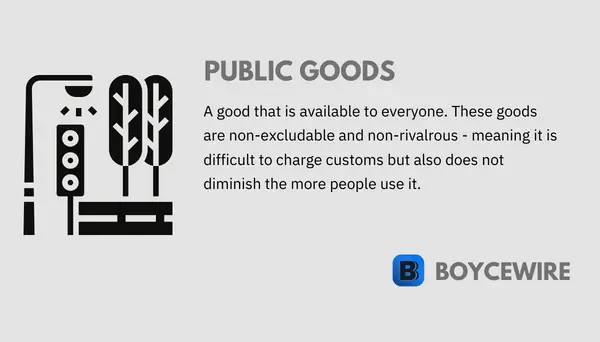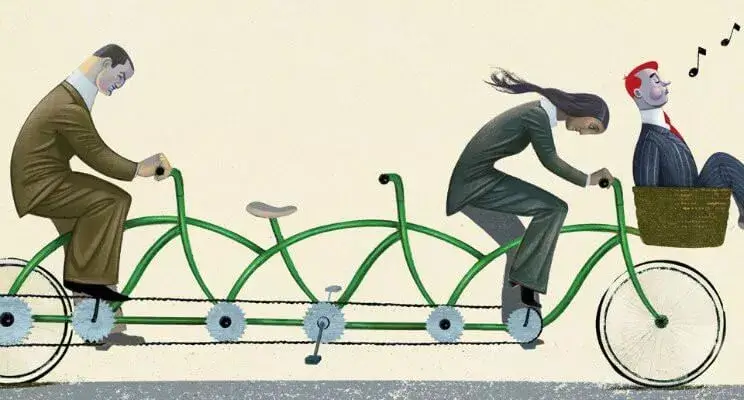Public Goods: Definition, Characteristics & Examples

What are Public Goods?
A public good is a good whereby no individual can be excluded from benefiting from it. In other words, everyone can benefit from its use. This could come in the form of a government public good such as education, or a natural public good such as air.
One of the key aspects of a public good is the fact that anyone can use it, but it doesn’t diminish its availability. For instance, one person can use a public streetlamp, yet it doesn’t diminish the ability for someone else to also use it.
Public goods are almost always funded publicly through the government. Perhaps the only public goods that aren’t, are natural goods such as air, the sun, and such.
Key Points
- A public good is a good that government provides which is both non-excludable and non-rivalrous.
- Examples of public goods include – defence, policing, streetlights, and lighthouses.
- Governments often seek to provide public goods when there is a market failure.
What are the Characteristics of Public Goods?
Public goods have two key characteristics – non-rivalry and non-excludability. Non-rivalry means that more than one person can use the good without diminishing others ability to use it. There is also non-excludability, which refers to the inability to restrict other consumers from using the good.

Non-excludability
Non-excludability means that the producer of the good is unable to prevent others from using it. For instance, it would be extremely difficult to prevent each person from using a traffic light. Doing so would require extreme levels of management and prevent the use of certain roads.
At the same time, non-excludability means customers cannot be directly charged. If we look again at traffic lights, it would be difficult but also chaotic to put in place a system whereby each user pays. So not only is it virtually impossible to prevent use but also collect payment.
Public goods such as defence, policing, and the law are all non-excludable. Everyone benefits from policing, which makes it impossible to charge some but not others. In turn, this presents us with the ‘free-rider problem’.
Free Rider Problem
As public goods are non-excludable, everyone has access to them. As a result, we have what is known as the ‘free-rider problem’, which means that people benefit from the good without contributing to its payment.
The issue with the free-rider problem stems from the fact that if certain individuals are not paying, then the rest will also be reluctant to pay. In turn, a private firm would produce fewer of such goods, resulting in a sub-optimal supply to society. Therefore, the solution would be for the government to pay for it from general taxation.

With public goods, the initial and subsequent costs are generally borne by the taxpayer. As a result, it is the taxpayer who bears the cost whilst others can benefit without paying for it.
The free-rider problem is considered a market failure because people are benefiting, yet not paying for the good. As a result, this can lead to an overuse of public goods. For instance, policing and the law are usually overstretched beyond their means.
Non-rivalry
With regards to public goods, non-rivalry means that other consumers are not excluded based on others consumption. In other words, just because Barry is using the streetlight does not mean that Susan is unable to.
Non-rivalry is often forgotten when looking at public goods. For instance, many will mistakenly consider universal healthcare as a public good. Whilst there is nothing to stop all citizens accessing it, there is a rivalrous component.
To explain, the more people who take up a bed in a hospital, the fewer there are for other patients. Similarly, the more doctors’ appointments taken, the fewer there is available for everyone else.
Public Goods Defined
There is a level of confusion that surrounds public goods. It may meet certain criteria to an extent but does not meet the two characteristics. These can be split down into four distinct categories: private goods, common goods, club goods, and public goods.

Private Goods
Private goods are those that are both excludable and rivalrous. In other words, people can be prevented from benefiting from the product. At the same time, the more one person consumes, the less there is available to others.
Such examples include: electronics, food, clothing, furniture, and most consumer goods.
Common Goods
Common goods are those that are non-excludable, but rivalrous. In other words, consumers cannot be stopped from benefiting from the good. However, it is rivalrous, which means that some may be excluded due to the consumption of others.
Such examples include: fish stocks, coal, timber, and other natural resources.
Club Goods
Club goods are those that are excludable, but non-rivalrous. In other words, a private firm is able to prevent people who do not paying from using it. Yet its increased consumption does not prevent others from accessing it.
Such examples include: TV, parks, and magazine subscriptions.
Public Goods
Public goods are those that are both non-excludable and non-rivalrous. IN other words, the supplier cannot prevent people from using the good, nor will its consumption prevent others from accessing it.
Such examples include: defence, policing, and streetlights.
Public Goods and Market Failure
When there is a market failure, it is argued that governments should step in to provide public goods. For example, if private companies are unable or unwilling to provide a good, then the government should step in. The reason for such is that public goods create a greater social benefit than the individual cost.
For example, everyone may be willing to spend $1 per month for policing. However, when measured collectively, this figure tends to increase. Consumers will value a public good more highly in the knowledge that others are also paying for it. As a result, the social value is said to be maximized when provided for by the public.
There are usually market failures with public goods because private entities are unwilling or unable to supply the socially optimal amount to the market. For example, there is no company or rational way by which a private firm would provide defece to a nation.
Perhaps some contractors could supply part of the market, but defence is often a big employer in most nations – particularly the US. This is known as a market failure because a private firm is unable to meet the necessary demand required. Therefore, the government steps in to provide the public good and overcome this market failure.
Argument against Public Goods
The issue with public goods is that it brings value to individuals who have not paid for the goods, which comes under the ‘free-rider’ problem.
So whilst it may create social benefits, it comes at a greater cost to some. For example, society may value the goods more highly, but this extra value is borne by involuntary taxation.
If we look at defence, for example, some agree with having a large military, and some don’t. By increasing the size of the military, jobs are created, and it can be argued that greater social value is created through more sophisticated defence systems. However, it is completely involuntary, and the minority must submit to the wishes of the majority.
The very nature of public goods comes under the assumption that the social value is greater than the private cost. However, this assumption is not always accurate. After all, it is impossible to gauge the social benefit to the millions of taxpayers. Do they truly value the construction of a new local park to tune the of $5 million? Does that social benefit exceed the cost? That is a question that is only answered by elected officials instead of the consumer.
Examples of Public Goods
Public goods must be both non-excludable and non-rivalrous. This is often overlooked when claiming certain goods to be ‘public goods’. For example, healthcare is often classified as a public good, as well as roads, tunnels, and bridges. However, they are all goods than can easily exclude others.
For example, toll roads can prevent the use of roads if there is no payment. These are known as ‘Quasi-public goods’, which we will look at in the next section.

Let us first look at some examples of public goods.
Clear Air
A public good that is not actually provided for by private or public organisations. Air is a natural element, although clean air is free from pollution and is non-excludable.
It is everywhere on earth, so it is non-excludable to anyone. At the same time, air is so plentiful that its consumption does not prevent anyone else’s.
Defence
Non-excludable in the fact that a nation can provide defence, yet everyone can benefit. Many will disagree or agree on the importance of defence spending, but it is impossible to exclude people from military protection (good or bad).
It is also non-rivalrous in the fact that defence is not actually consumable. In other words, one person cannot consume a level of defence. It is universal and non-consumable – making it a public good.
Lighthouses
One of the classic examples of public goods. It is non-excludable in the fact that it would be difficult to prevent ships from sailing by and benefiting.
At the same time, it is non-rivalrous in that many ships can use the lighthouse at the same time without diminishing others ability to use it.
Public Park
Another example of a public good is the public park. It is both non-excludable in the fact that everyone has access to the park, but also non-rivalrous as one consumer does not restrict the ability of another to enjoy the public good.
Streetlamps
It is near impossible to exclude people form making use of streetlamp at night. It is also impossible to obtain payment from each and everyone that uses it.
Furthermore, streetlamp are equally non-rivalrous. One person standing under a streetlamp does no prevent someone else walking by from benefiting from the light.
Quasi-Public Goods
Quasi-public goods are a sort of hybrid between private goods and public goods. They have characteristics of both. For example, they are partially excludable, and are partially rivalrous. Some of these goods include roads, tunnels, the internet, and TV.

Whilst such goods are commonly non-excludable, there are toll roads, pay-to-access websites, and premium cable TV. All of them require payment to access and can easily and profitably exclude people.
Quasi-public goods are sometimes considered public goods because private businesses may be unwilling or unable to fulfil the nations demand.
For instance, private companies may be able to construct new roads and implement tolls. However, they are unlikely to be able to do this on a national scale.
Public Goods vs Private Goods
Private goods and public goods are complete opposites. Whilst public goods are non-rivalrous and non-excludable, private goods are rivalrous and excludable. In other words, public goods are unable to exclude people.
By contrast, a private good can exclude people from its use, usually in a monetary fashion. For instance, you have to pay to get into the cinema.
The cinema prevents those without a ticket from getting into the theatre. By contrast, there is no feasible way of doing this. That, or it would be incredibly expensive to do so.
Public Goods = Non-rivalrous and Non-excludable
Private Goods = Rivalrous and Excludable
At the same time, private goods are rivalrous. In other words, the more one person consumers, the less there is for others. For instance, there is only a limited quantity of cakes in a bakery at any one time. So the more customers that purchase doughnuts the fewer are available to others.
Related Topics
FAQs
Some examples of public goods include: defence, lighthouses, streetlamps, and clean air. They are all non-excludable and non-rivalrous as defined by public good.
The public goods problem arises from the ‘free-rider’ phenomenon. This is caused by people benefiting from the public good, but not contributing to its expense.
Quasi public goods are goods that are partially rivarlous and partially excludable. However, they do not come under the classificaiton of a private or a public good. Rather, it is somewhere in between.
Such examples of quasi public goods include: roads, television, and the internet.
Education is not a public good because it is excludable, and to an extent, rivalrous. It is excludable in the fact that schools are able to reject applicants based on their location. Or, in private schools, based on their ability to pay. So students can be excluded, and therefore education cannot be classified as a public good.
Furthermore, it can also be considered rivalrous. With only 30 places available, the more students that fill up the spaces, the fewer there are available to someone else.
About Paul
Paul Boyce is an economics editor with over 10 years experience in the industry. Currently working as a consultant within the financial services sector, Paul is the CEO and chief editor of BoyceWire. He has written publications for FEE, the Mises Institute, and many others.

Further Reading
 Fisher Equation - The Fisher equation relates nominal interest rates, real interest rates, and expected inflation, providing insight into the interplay between interest…
Fisher Equation - The Fisher equation relates nominal interest rates, real interest rates, and expected inflation, providing insight into the interplay between interest…  Sunk Cost: What it is, Examples & Fallacy - A sunk cost is a payment that has been made but cannot now be recovered.
Sunk Cost: What it is, Examples & Fallacy - A sunk cost is a payment that has been made but cannot now be recovered.  Enron Scandal - The Enron scandal refers to a major corporate fraud involving the energy company Enron Corporation, characterized by deceptive accounting practices…
Enron Scandal - The Enron scandal refers to a major corporate fraud involving the energy company Enron Corporation, characterized by deceptive accounting practices… 
